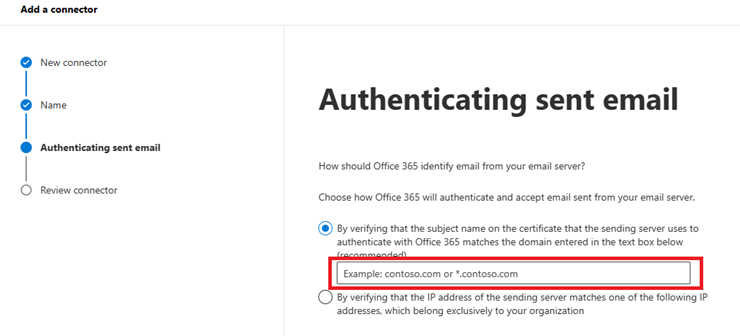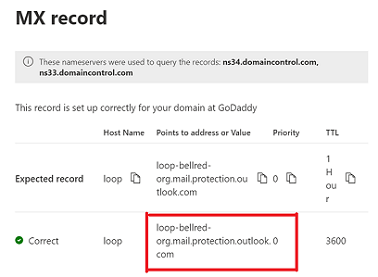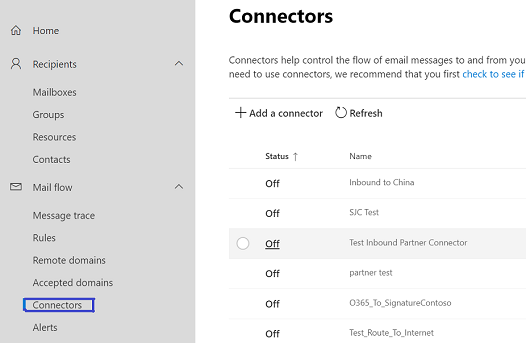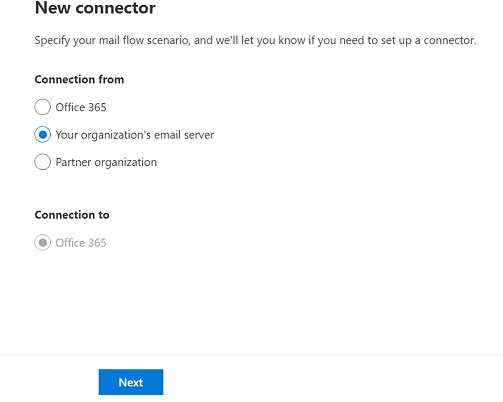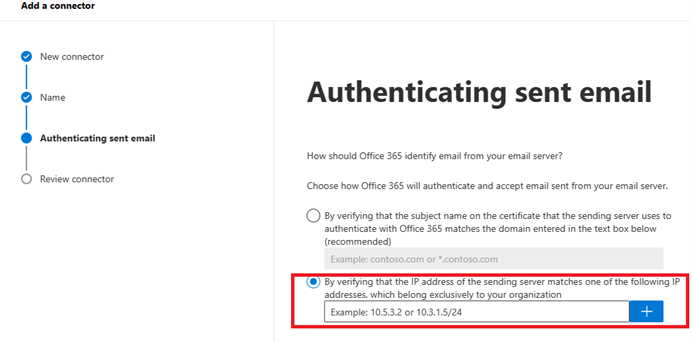How to set up a multifunction device or application to send emails using Microsoft 365 or Office 365
This article explains how you can send emails from devices and business applications when all of your mailboxes are in Microsoft 365 or Office 365. For example:
- You have a scanner, and you want to email scanned documents to yourself or someone else.
- You have a line-of-business (LOB) application that manages appointments, and you want to email reminders to clients of their appointment time.
Option 1: Authenticate your device or application directly with a Microsoft 365 or Office 365 mailbox, and send mail using SMTP AUTH client submission
Note
This option isn't compatible with Security defaults in Microsoft Entra ID. We recommend using Modern Authentication when connecting with our service. For more information about OAuth, see Authenticate an IMAP, POP or SMTP connection using OAuth.
You must also verify that SMTP AUTH is enabled for the mailbox being used. SMTP AUTH is disabled for organizations created after January 2020 but can be enabled per-mailbox. For more information, see Enable or disable authenticated client SMTP submission (SMTP AUTH) in Exchange Online.
Although SMTP AUTH is available now, we announced Exchange Online will permanently remove support for Basic authentication with Client Submission (SMTP AUTH) in September 2025. We strongly encourage customers to move away from using Basic authentication with SMTP AUTH as soon as possible. For more Information about alternative options, please see our announcement here- https://techcommunity.microsoft.com/t5/exchange-team-blog/exchange-online-to-retire-basic-auth-for-client-submission-smtp/ba-p/4114750
This option supports most usage scenarios and is the easiest to set up. Choose this option when:
- You want to send emails from a third-party hosted application, service, or device.
- You want to send emails to people inside and outside your organization.
To configure your device or application, connect directly to Microsoft 365 or Office 365 using the SMTP AUTH client submission endpoint smtp.office365.com.
Each device or application must be able to authenticate with Microsoft 365 or Office 365. The email address of the account that's used to authenticate with Microsoft 365 or Office 365 will appear as the sender of messages from the device or application.
How to set up SMTP AUTH client submission
Enter the following settings directly on your device or in the application as their guide instructs (it might use different terminology than this article). As long as your scenario meets the requirements for SMTP AUTH client submission, the following settings will enable you to send emails from your device or application:
| Device or Application setting | Value |
|---|---|
| Server/smart host | smtp.office365.com |
| Port | Port 587 (recommended) or port 25 |
| TLS/StartTLS | Enabled |
| Username/email address and password | Enter the sign-in credentials of the hosted mailbox being used |
Transport Layer Security (TLS) and other encryption options
Determine what version of Transport Layer Security (TLS) your device supports by checking the device guide or with the vendor. If your device or application doesn't support TLS 1.2 or above, you have the following alternatives:
- Depending on your requirements, use direct send (Option 2) or Opt in to the Exchange Online endpoint for legacy TLS clients using SMTP AUTH
- Use an on-premises email server (Exchange Server or any other SMTP server) to relay mail if your device is unable to meet the previous requirements for connecting to Microsoft 365 or Office 365. In fact, you might find it easier to configure and manage an on-premises SMTP server to relay messages from your devices and applications, especially if you have many devices and applications that send emails.
For more information about configuring your own email server to send mail to Microsoft 365 or Office 365, see Set up connectors to route mail between Microsoft 365 or Office 365 and your own email servers.
Note
If your device recommends or defaults to port 465, it doesn't support SMTP AUTH client submission.
Features of SMTP AUTH client submission
- SMTP AUTH client submission allows you to send emails to people inside and outside your organization.
- This method bypasses most spam checks for emails sent to people in your organization. This bypass can help protect your company IP addresses from being blocked by a spam list.
- With this method, you can send emails from any location or IP address, including your (on-premises) organization's network, or a third-party cloud-hosting service like Microsoft Azure.
Requirements for SMTP AUTH client submission
- Authentication: We recommend using Modern Authentication in the form of OAuth, if possible. Otherwise, you'll need to use Basic Authentication (which is simply a username and password) to send emails from the device or application. For more information about OAuth, see Authenticate an IMAP, POP, or SMTP connection using OAuth. If SMTP AUTH is intentionally disabled for the organization or the mailbox being used, you must use Option 2 or 3 below.
- Mailbox: You must have a licensed Microsoft 365 or Office 365 mailbox to send emails from.
- Transport Layer Security (TLS): Your device must be able to use TLS version 1.2 and above.
- Port: Port 587 (recommended) or port 25 is required and must be unblocked on your network. Some network firewalls or ISPs block ports, especially port 25, because that's the port that email servers use to send emails.
- DNS: Use the DNS name smtp.office365.com. Don't use an IP address for the Microsoft 365 or Office 365 server, as IP Addresses aren't supported.
Note
For information about TLS, see How Exchange Online uses TLS to secure email connections and for detailed technical information about how Exchange Online uses TLS with cipher suite ordering, see TLS cipher suites supported by Office 365.
Limitations of SMTP AUTH client submission
If the printer or application wants to send emails from a different account, the sign-in account should have Send As permission over that account. Otherwise, the result is an error similar to:
5.7.60 SMTP; Client does not have permissions to send as this sender.
Microsoft 365 or Office 365 imposes some sending limits. See Exchange Online limits - Receiving and sending limits for more information.
Option 2: Send mail directly from your printer or application to Microsoft 365 or Office 365 (direct send)
Choose this option when:
- Your environment has SMTP AUTH disabled.
- SMTP AUTH client submission (Option 1) isn't compatible with your business needs or with your device.
- You only need to send messages to recipients in your own organization who have mailboxes in Microsoft 365 or Office 365; you don't need to send emails to people outside of your organization.
Other scenarios when direct send may be your best choice:
You want your device or application to send from each user's email address and don't want each user's mailbox credentials configured to use SMTP client submission. Direct send allows each user in your organization to send emails using their own address.
Avoid using a single mailbox with Send As permissions for all your users. This method isn't supported because of complexity and potential issues.
You want to send bulk emails or newsletters. Microsoft 365 or Office 365 doesn't allow you to send bulk messages via SMTP AUTH client submission. Direct send allows you to send a higher volume of messages.
There is a risk of your email being marked as spam by Microsoft 365 or Office 365. You might want to enlist the help of a bulk email provider to assist you. For example, they'll help you adhere to best practices, and can help ensure that your domains and IP addresses aren't blocked by others on the internet.
Settings for direct send
Enter the following settings on the device or in the application directly:
| Device or application setting | Value |
|---|---|
| Server/smart host | Your MX endpoint, for example, contoso-com.mail.protection.outlook.com |
| Port | Port 25 |
| TLS/StartTLS | Optional |
| Email address | Any email address for one of your Microsoft 365 or Office 365 accepted domains. This email address doesn't need to have a mailbox. |
We recommend adding a Sender Policy Framework (SPF) record to avoid having messages flagged as spam. If you're sending from a static IP address, add it to your SPF record in your domain registrar's DNS settings as follows:
| DNS entry | Value |
|---|---|
| SPF | v=spf1 ip4:<Static IP Address> include:spf.protection.outlook.com ~all |
Step-by-step instructions for direct send
If your device or application can send from a static public IP address, obtain this IP address and make a note of it. You can share your static IP address with other devices and users, but don't share the IP address with anyone outside of your company. Your device or application can send from a dynamic or shared IP address but messages are more prone to antispam filtering.
Sign in to the Microsoft 365 admin center.
Go to Settings > Domains, select your domain (for example, contoso.com), and find the MX record.
The MX record will have data for Points to address or value that looks similar to
contoso-com.mail.protection.outlook.com.Make a note of the data of Points to address or value for the MX record, which we refer to as your MX endpoint.
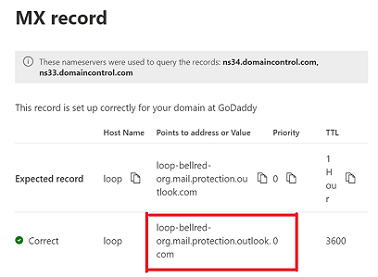
Go back to the device, and in the settings, under what would normally be called Server or Smart Host, enter the MX record Points to address or value you noted in step 4.
Note
Do NOT use an IP address for the Microsoft 365 or Office 365 server connection, as IP addresses aren't supported.
Now that you are done configuring your device settings, go to your domain registrar's website to update your DNS records. Edit your SPF record. In the entry, include the IP address that you noted in step 1. The finished string looks similar to the following example:
v=spf1 ip4:10.5.3.2 include:spf.protection.outlook.com ~allwhere 10.5.3.2 is your public IP address.
Note
Skipping this step might cause emails to be sent to recipient Junk Email folders.
Caution
This IP address will be authorized to send on your domain's behalf. Anyone with access to it could send emails to any external recipient and it would pass SPF checking. You should consider carefully who has access to use this IP address.
To test the configuration, send a test email from your device or application, and confirm that the recipient received it.
How direct send works
The application or device in your organization's network uses direct send and your Microsoft 365 or Office 365 mail exchange (MX) endpoint to send emails to recipients in your organization. It's easy to find your MX endpoint in Microsoft 365 or Office 365 if you need to look it up.
You can configure your device to send emails directly to Microsoft 365 or Office 365. Use direct send method to send email to recipients with Microsoft 365 or Office 365 mailboxes in your organization. If your device uses direct send to try to relay an email for a recipient who doesn't have a Microsoft 365 or Office 365 mailbox, the email will be rejected.
Note
If your device or application has the ability to act as an email server to deliver messages to Microsoft 365 or Office 365 and to other email providers, there are no Microsoft 365 or Office 365 settings needed for this scenario. For more information, see your device or application instructions.
Features of direct send
- Uses Microsoft 365 or Office 365 to send emails, but doesn't require a dedicated Microsoft 365 or Office 365 mailbox.
- Doesn't require your device or application to have a static IP address. However, it's recommended for your device or application to have a static IP address, if possible.
- Doesn't work with a connector; never configure a device to use a connector with direct send because such a configuration can cause problems.
- Doesn't require your device to support TLS.
Direct send has higher sending limits than SMTP client submission. Senders aren't bound by the limits described in Option 1.
Requirements for direct send
- Port: Port 25 is required and must be unblocked on your network.
- Static IP address is recommended: A static IP address is recommended so that an SPF record can be created for your domain. The SPF record helps avoid your messages being flagged as spam.
- Doesn't require a Microsoft 365 or Office 365 mailbox with a license.
Limitations of direct send
- Direct send cannot be used to deliver emails to external recipients, for example, recipients with Yahoo or Gmail addresses.
- Your messages will be subject to antispam checks.
- Sent mail might be disrupted if your IP addresses are blocked by a spam list.
- Microsoft 365 and Office 365 use throttling policies to protect the performance of the service.
Option 3: Configure a connector to send emails using Microsoft 365 or Office 365 (SMTP relay)
This option is more difficult to implement than the others. Choose this option only when:
- Your environment has SMTP AUTH disabled.
- SMTP client submission (Option 1) isn't compatible with your business needs or with your device
- You can't use direct send (Option 2) because you must send emails to external recipients.
SMTP relay lets Microsoft 365 or Office 365 relay emails on your behalf by using a connector that's configured with a TLS certificate (recommended) or your public IP address. Setting up a connector makes this option more complicated.
Configure your setup only when you have fulfilled either of the following conditions:
- Sender domain: Ensure that the sender domain belongs to your organization (that is, you've registered your domain in Microsoft 365). For more information, see Add a domain to Microsoft 365.
- Certificate-based connector configuration: Ensure that your on-premises email server is configured to use a certificate to send email to Microsoft 365, and the Common-Name (CN) or Subject Alternate Name (SAN) in the certificate contains a domain name that you have registered in Microsoft 365, and you have created a certificate-based connector in Microsoft 365 that has that domain.
If neither of the above conditions have been fulfilled, Microsoft 365 can't determine whether the message that was sent from the device or application belongs to your organization. Therefore, you should ensure that you meet either of the above conditions.
Configure a TLS certificate-based connector to relay email through Microsoft 365 or Office 365
First, configure your device or application by entering the settings as described in the following table:
| Device or application setting | Value |
|---|---|
| Server/smart host | Your MX endpoint, for example, yourdomain- com.mail.protection.outlook.com |
| Port | Port 25 |
| TLS/StartTLS | Must be enabled and only TLS 1.2 is supported |
| TLS Certificate CN (Common Name) or SAN (Subject Alternative Name) | The certificate which has CN or SAN that contains a domain name you've registered with your Office 365 organization. |
| Email address | This can be any email address. |
If you already have a connector that's configured to deliver messages from your on-premises organization to Microsoft 365 or Office 365 (for example, a hybrid environment), you probably don't need to create a dedicated connector for Microsoft 365 or Office 365 SMTP relay. To create or change a certificate-based connector, perform the following steps:
Sign in to Exchange admin center. For more information, see Exchange admin center in Exchange Online.
On the left navigation pane, select mail flow, select Connectors, and then do the following:
On the Select your mail flow scenario page, select the Your organization's email server radio button under Connection from.
Once you choose Your organization's email server from the Connection from drop-down, Office 365 is automatically chosen from the Connection to drop-down.
Enter the connector name and other information, and then select Next.
On the Authenticating sent email page, select the first option to use the subject name on the certificate of the sending server to authenticate with Office 365. The domain name in the option should match the CN or SAN in the certificate used by your server, device, or application.
Note
This domain must be the one that belongs to your organization, that is, this domain should be the one you've registered with Microsoft 365. For more information, see Add a domain to Microsoft 365.
For example, Contoso.com belongs to your organization, and it's part of the CN or SAN in the certificate that your service, device, or application uses to communicate with Microsoft 365. If there are multiple domains in the certificate (such as mail1.contoso.com, mail2.contoso.com, and so on), we recommend that the domain in the connector UI be *.contoso.com.
Existing hybrid customers who used the Hybrid Configuration Wizard to configure their connectors should check their existing connector to ensure that it uses *.contoso.com instead of mail.contoso.com or hostname.contoso.com. This domain verification is because mail.contoso.com and hostname.contoso.com may not be registered domains in Microsoft 365.
To avoid having messages flagged as spam, we recommend adding an SPF record for your domain in the DNS settings at your domain registrar. Additionally, if you are sending from a static IP address, add that address to your SPF record.
For more information about this method, see important notice for email customers who have configured connectors.
Configure an IP Address-based connector to relay email through Microsoft 365 or Office 365
Configure an IP Address-based connector to relay email through Microsoft 365 or Office 365 by entering the settings as described in the following table:
| Device or application setting | Value |
|---|---|
| Server/smart host | Your MX endpoint, for example, yourdomain- com.mail.protection.outlook.com |
| Port | Port 25 |
| TLS/StartTLS | Enabled |
| Email address | Any email address in one of your Microsoft 365- or Office 365-verified domains. This email address doesn't need a mailbox. |
If you already have a connector that's configured to deliver messages from your on-premises organization to Microsoft 365 or Office 365 (for example, a hybrid environment), you probably don't need to create a dedicated connector for Microsoft 365 or Office 365 SMTP relay. If you need to create a connector, use the following settings to support this scenario:
| Connector setting | Value |
|---|---|
| From | Your organization's email server |
| To | Microsoft 365 or Office 365 |
| Domain restrictions: IP address/range | Your on-premises IP address or address range that the device or application will use to connect to Microsoft 365 or Office 365 |
We recommend adding an SPF record to avoid having messages flagged as spam. If you are sending from a static IP address, add it to your SPF record in your domain registrar's DNS settings as follows:
| DNS entry | Value |
|---|---|
| SPF | v=spf1 ip4:Static IP Address include:spf.protection.outlook.com ~all |
Create and configure an inbound connector in your Microsoft 365 organization
To create and configure an inbound connector in your Microsoft 365 organization, perform the following steps:
Obtain the public (static) IP address that the device or application will send from. A dynamic IP address isn't supported or allowed. You can share your static IP address with other devices and users, but don't share the IP address with anyone outside of your company. Note this IP address for later use/reference.
Sign in to Microsoft 365 admin center.
Go to Settings > Domains, select your domain (for example, contoso.com), and find the MX record. The MX record will have data of the POINTS TO ADDRESS value which looks similar to
contoso-com.mail.protection.outlook.com.Note the data of the POINTS TO ADDRESS value for the MX record, which we refer to as your MX endpoint.
Check that the domains that the application or device will send to have been verified. If the domain isn't verified, emails could be lost, and you won't be able to track them with the Exchange Online message trace tool.
In Microsoft 365 or Office 365, select Admin and then select Exchange to go to the new Exchange admin center.
Note
On selecting Exchange, the new Exchange admin center is launched.
In the EAC, go to Mail flow > Connectors.
Check the list of connectors set up for your organization.
If there is no connector listed from your organization's email server to Microsoft 365 or Office 365, go to the EAC and perform the following steps to create a connector:
Select +Add a connector.
In the wizard that opens, choose the options that are depicted in the following screenshot on the first screen:
Select Next. The Connector name page appears.
Provide a name for the connector and select Next. The Authenticating sent email page appears.
Select the By verifying that the IP address of the sending server matches one of these IP addresses which belong exclusively to your organization radio button, and add the IP address from Step 1 of Step-by-step configuration instructions for SMTP relay.
Select Save.
Now that you're done with configuring your Microsoft 365 or Office 365 settings, go to your domain registrar's website to update your DNS records. Edit your SPF record. Include the IP address that you noted in step 1. The finished string should look similar to this
v=spf1 ip4:10.5.3.2 include:spf.protection.outlook.com ~all, where 10.5.3.2 is your public IP address.Important
Skipping this step can cause email to be sent to recipient Junk Email folders.
Now, go back to the device, and in the settings, find the entry for Server or Smart Host, and enter the MX record POINTS TO ADDRESS value that you recorded in step 3.
To test the configuration, send a test email from your device or application, and confirm that it was received by the recipient.
Step-by-step configuration instructions for SMTP relay
Obtain the public (static) IP address that the device or application will send from. A dynamic IP address isn't supported or allowed. You can share your static IP address with other devices and users, but don't share the IP address with anyone outside of your company. Make a note of this IP address for later use/reference.
Sign in to the Microsoft 365 admin center.
Go to Settings > Domains, select your domain (for example, contoso.com), and find the MX record.
The MX record will have data for Points to address or value that looks similar to
contoso-com.mail.protection.outlook.com.Make a note of data of Points to address or value for the MX record, which we refer to as your MX endpoint.

Check that the domains that the application or device will send to have been verified. If the domain isn't verified, emails could be lost, and you won't be able to track them with the Exchange Online message trace tool.
In Microsoft 365 or Office 365, select Admin and then Exchange to go to the new Exchange admin center.
Note
On selecting Exchange, the Exchange admin center (EAC) is launched.
In the EAC, go to Mail flow > Connectors.
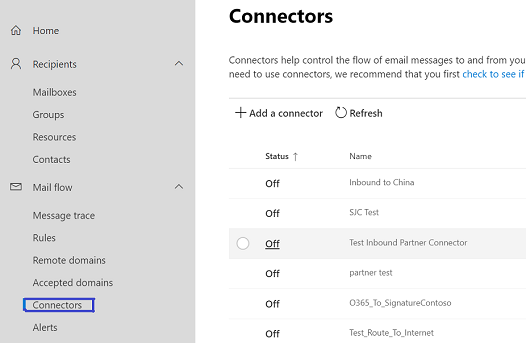
Check the list of connectors set up for your organization.
If there is no connector listed from your organization's email server to Microsoft 365 or Office 365, go to the EAC and perform the following steps to create a connector.
Select +Add a connector as shown in the following screenshot:

In the wizard that opens, choose the options that are depicted in the following screenshot on the first screen:
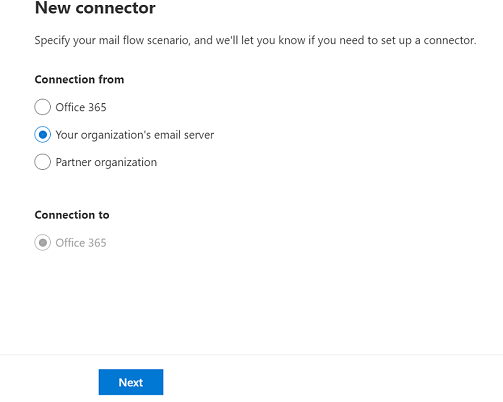
Select Next. The Connector name screen appears.
Provide a name for the connector and select Next. The Authenticating sent email screen appears.
Choose By verifying that the IP address of the sending server matches one of these IP addresses which belong exclusively to your organization, and add the IP address from Step 1 of Step-by-step configuration instructions for SMTP relay section.
Select Save.
Now that you're done with configuring your Microsoft 365 or Office 365 settings, go to your domain registrar's website to update your DNS records. Edit your SPF record. Include the IP address that you noted in step 1. The finished string should look similar to this
v=spf1 ip4:10.5.3.2 include:spf.protection.outlook.com ~all, where 10.5.3.2 is your public IP address. Skipping this step can cause emails to be sent to recipient Junk Email folders.Now, go back to the device, and in the settings, find the entry for Server or Smart Host, and enter the MX record POINTS TO ADDRESS value that you recorded in step 3.
To test the configuration, send a test email from your device or application, and confirm that it was received by the recipient.
How Microsoft 365 or Office 365 SMTP relay works
The application or device in your organization's network uses a connector for SMTP relay to send emails to recipients in your organization.
The Microsoft 365 or Office 365 connector that you configure authenticates your device or application with Microsoft 365 or Office 365 using an IP address. Your device or application can send emails using any address (including ones that can't receive emails), as long as the address uses one of your domains. It's not mandatory for the email address to be associated with an actual mailbox. For example, if your domain is contoso.com, you could send from an address like do_not_reply@contoso.com.
Microsoft 365 or Office 365 SMTP relay uses a connector to authenticate the emails sent from your device or application. This authentication method allows Microsoft 365 or Office 365 to relay those messages to your own mailboxes and external recipients. Microsoft 365 or Office 365 SMTP relay is similar to direct send except that it can send emails to external recipients.
Due to the added complexity of configuring a connector, direct send is recommended over Microsoft 365 or Office 365 SMTP relay, unless you must send emails to external recipients. To send emails using Microsoft 365 or Office 365 SMTP relay, your device or application server must have a static IP address or address range. You can't use SMTP relay to send emails directly to Microsoft 365 or Office 365 from a third-party hosted service, such as Microsoft Azure. For more information, see Troubleshoot outbound SMTP connectivity issues in Azure.
Features of Microsoft 365 or Office 365 SMTP relay
- Microsoft 365 or Office 365 SMTP relay doesn't require the use of a licensed Microsoft 365 or Office 365 mailbox to send emails.
- Microsoft 365 or Office 365 SMTP relay has higher sending limits than SMTP client submission. Senders aren't subject to the limits described in Option 1.
Requirements for Microsoft 365 or Office 365 SMTP relay
- Static IP address or address range: Most devices or applications are unable to use a certificate for authentication. To authenticate your device or application, use one or more static IP addresses that aren't shared with another organization.
- Connector: Set up a connector in Exchange Online for emails sent from your device or application.
- Port: Port 25 is required. Ensure this port isn't blocked on your network or by your ISP.
Limitations of Microsoft 365 or Office 365 SMTP relay
- Sent mail can be disrupted if your IP addresses are blocked by a spam list.
- Reasonable limits are imposed for sending. For more information, see High-risk delivery pool for outbound messages.
- Requires static unshared IP addresses (unless a certificate is used).
- The connecting client is expected to retry within a reasonable period, in case of transient failures. Microsoft recommends the connecting client to maintain SMTP logs to help investigate these types of failures.
Note
As per SMTP RFC suggestion, Option 1 SMTP AUTH client submission may be a more appropriate method for an SMTP client/application, which isn't a full-featured mail server (MTA).
Compare the options
Here's a comparison of each configuration option and the features they support.
| Features | SMTP client submission | Direct send | SMTP relay |
|---|---|---|---|
| Send to recipients in your domain(s) | Yes | Yes | Yes |
| Relay to internet via Microsoft 365 or Office 365 | Yes | No. Direct delivery only. | Yes |
| Bypasses antispam | Yes, if the email is destined for one of your Microsoft 365 or Office 365 mailboxes. | No. Suspicious emails might be filtered. We recommend a custom SPF record. | No. Suspicious emails might be filtered. We recommend a custom SPF record. |
| Supports mail sent from applications hosted by a third party | Yes | Yes. We recommend updating your SPF record to allow the third party to send as your domain. | No |
| Saves to Sent Items folder | Yes | No | No |
| Requirements | |||
| Open network port | Port 587 or port 25 | Port 25 | Port 25 |
| Device or application server must support TLS | Required | Optional | Optional |
| Requires authentication | Microsoft 365 or Office 365 username and password required | None | One or more static IP addresses. Your printer or the server running your LOB app must have a static IP address to use for authentication with Microsoft 365 or Office 365. |
Here are the limitations of each configuration option:
| Limitations | SMTP client submission | Direct send | SMTP relay |
|---|---|---|---|
| Throttling limits | 10,000 recipients per day. 30 messages per minute. | Standard throttling is in place to protect Microsoft 365 or Office 365. | Reasonable limits are imposed. The service can't be used to send spam or bulk mail. For more information about reasonable limits, see High-risk delivery pool for outbound messages. |
Run diagnostic to Set up applications or devices sending email using Microsoft 365
Note
This feature requires a Microsoft 365 administrator account.
If you still need help to set up applications or devices sending emails using Microsoft 365 or you need help fixing issues with applications or devices sending emails using Microsoft 365, you can run an automated diagnostic.
To run the diagnostic check, select the following button:
A flyout page opens in the Microsoft 365 admin center. Select the appropriate option that you're looking for, for example, new setup or troubleshooting existing setup.
Use your own email server to send emails from multifunction devices and applications
If you happen to have an on-premises email server, you should seriously consider using that server for SMTP relay instead of Microsoft 365 or Office 365. A local email server that you have physical access to is much easier to configure for SMTP relay by devices and applications on your local network.
Note
The use of IIS SMTP Virtual Server for email transmission isn't supported, as it's obsolete since it relies on an outdated IIS SMTP component whose support ceased with Windows Server 2003. For email relaying to Office 365, utilize a supported version of Exchange Server or Azure Communication Service.
The details about how to do this configuration are determined by your on-premises email server. For Exchange Server, see the following articles:
- Allow anonymous relay on Exchange servers
- Receive messages from a server, service, or device that doesn't use Exchange
Related articles
Set up connectors to route mail between Microsoft 365 or Office 365 and your own email servers

